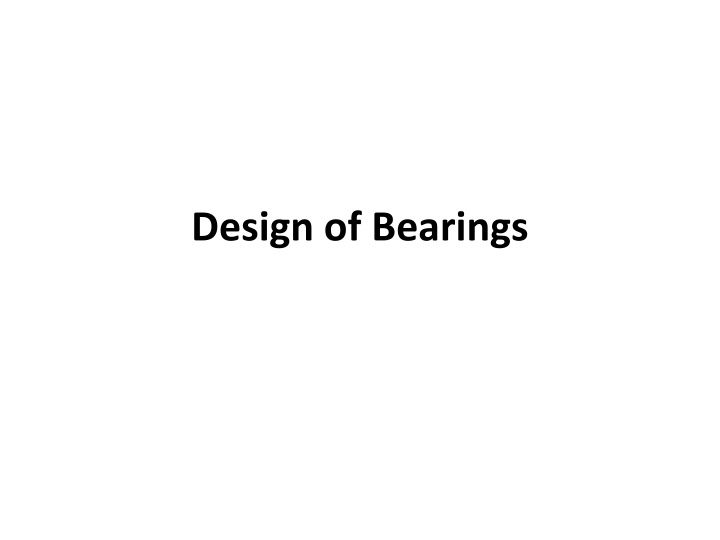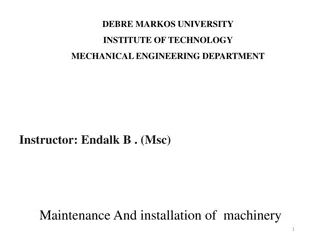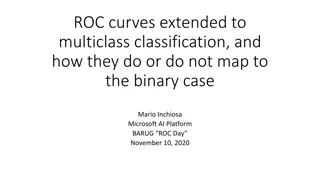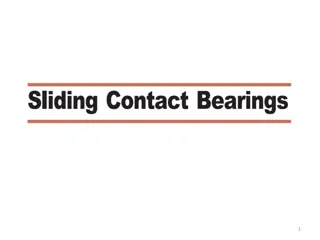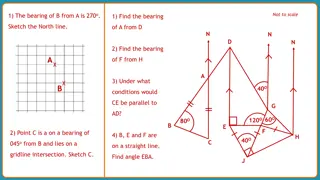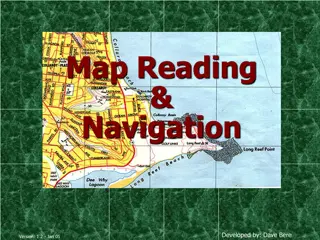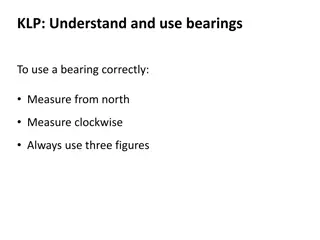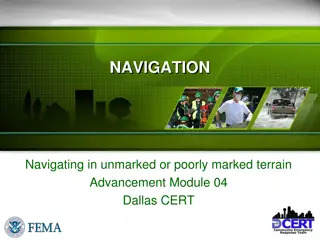A Comprehensive Guide to Bearings Design and Classification
Bearings play a crucial role in supporting moving machine elements by enabling relative motion while carrying loads. This guide covers the introduction, classification, types of sliding contact bearings, and the working mechanism of bearings. It further delves into the properties of sliding contact bearing materials, highlighting compressive strength and fatigue strength requirements. Explore the diverse designs and functionalities of bearings in various applications.
Download Presentation

Please find below an Image/Link to download the presentation.
The content on the website is provided AS IS for your information and personal use only. It may not be sold, licensed, or shared on other websites without obtaining consent from the author.If you encounter any issues during the download, it is possible that the publisher has removed the file from their server.
You are allowed to download the files provided on this website for personal or commercial use, subject to the condition that they are used lawfully. All files are the property of their respective owners.
The content on the website is provided AS IS for your information and personal use only. It may not be sold, licensed, or shared on other websites without obtaining consent from the author.
E N D
Presentation Transcript
Introduction A bearing is a machine element which support another moving machine element (known as journal). It permits a relative motion between the contact surfaces of the members, while carrying the load. Due to the relative motion between the contact surfaces, a certain amount of power is wasted in overcoming frictional resistance and if the rubbing surfaces are in direct contact, there will be rapid wear. To reduce frictional resistance and wear and in some cases to carry away the heat generated, a layer of fluid (known as lubricant) may be provided. The lubricant used to separate the journal and bearing is usually a mineral oil refined from petroleum, but vegetable oils, silicon oils, greases etc., may be used.
Classification of Bearings 1. Depending upon the direction of load to be supported. a) Radial bearings, and (b) Thrust bearings.
2. Depending upon the nature of contact. (a) Sliding contact bearings, and (b) Rolling contact bearings.
4. The sliding contact bearings, according to the thickness of layer of the lubricant 1. Thick film bearings. The thick film bearings are those in which the working surfaces are completely separated from each other by the lubricant. Such type of bearings are also called as hydrodynamic lubricated bearings. 2. Thin film bearings. The thin film bearings are those in which, although lubricant is present, the working surfaces partially contact each other atleast part of the time. Such type of bearings are also called boundary lubricated bearings. 3. Zero film bearings. The zero film bearings are those which operate without any lubricant present. 4. Hydrostatic or externally pressurized lubricated bearings. The hydrostatic bearings are those which can support steady loads without any relative motion between the journal and the bearing. This is achieved by forcing externally pressurized lubricant between the members.
6. Properties of Sliding Contact Bearing Materials 1. Compressive strength: The maximum bearing pressure is considerably greater than the average pressure obtained by dividing the load to the projected area. Therefore the bearing material should have high compressive strength to withstand this maximum pressure so as to prevent extrusion or other permanent deformation of the bearing. 2. Fatigue strength: The bearing material should have sufficient fatigue strength so that it can withstand repeated loads without developing surface fatigue cracks. It is of major importance in aircraft and automotive engines. 3. Comformability: It is the ability of the bearing material to accommodate shaft deflections and bearing inaccuracies by plastic deformation (or creep) without excessive wear and heating.
Properties.. 4. Embeddability. It is the ability of bearing material to accommodate (or embed) small particles of dust, grit etc., without scoring the material of the journal. 5. Bondability. Many high capacity bearings are made by bonding one or more thin layers of a bearing material to a high strength steel shell. Thus, the strength of the bond i.e. bondability is an important consideration in selecting bearing material.
Properties 6. Corrosion resistance. The bearing material should not corrode away under the action of lubricating oil. This property is of particular importance in internal combustion engines where the same oil is used to lubricate the cylinder walls and bearings. In the cylinder, the lubricating oil comes into contact with hot cylinder walls and may oxidise and collect carbon deposits from the walls. 7. Thermal conductivity. The bearing material should be of high thermal conductivity so as to permit the rapid removal of the heat generated by friction. 8. Thermal expansion. The bearing material should be of low coefficient of thermal expansion, so that when the bearing operates over a wide range of temperature, there is no undue change in the clearance.
Properties of metallic bearing materials.
7. Lubricants The lubricants are used in bearings to reduce friction between the rubbing surfaces and to carry away the heat generated by friction. It also protects the bearing against corrosion. All lubricants are classified into the following three groups : 1. Liquid: Minerals oil & Synthetic oil 2. Semi-liquid : Grease (heavy viscosity), use where high pressure and low velocity exist. 3. Solid: Graphite's are useful in reducing friction where oil films cannot be maintained because of pressures or temperatures.
8. Terms used in Hydrodynamic Journal Bearing: A hydrodynamic journal bearing is shown in Fig, in which O is the centre of the journal and O is the centre of the bearing. Let D = Diameter of the bearing, d = Diameter of the journal, and l = Length of the bearing. The following terms used in hydrodynamic journal bearing are important from the subject point of view :
Terms. 1. Diametral clearance. It the difference between the diameters of the bearing and the journal. Mathematically, diametral clearance, c = D d 2. Radial clearance. It is the difference between the radii of the bearing and the journal. Mathematically, radial clearance, 3. Diametral clearance ratio. It is the ratio of the diametral clearance to the diameter of the journal. Mathematically, diametral clearance ratio
Terms.. 4. Eccentricity. It is the radial distance between the centre (O) of the bearing and the displaced centre (O ) of the bearing under load. It is denoted by e. 5. Minimum oil film thickness. It is the minimum distance between the bearing and the journal, under complete lubrication condition. It is denoted by h0 and occurs at the line of centers as shown in Fig. Its value may be assumed as c / 4. 6. Attitude or eccentricity ratio. It is the ratio of the eccentricity to the radial clearance. Mathematically, attitude or eccentricity ratio, 7. Short and long bearing. If the ratio of the length to the diameter of the journal (i.e. l / d) is less than 1, then the bearing is said to be short bearing. On the other hand, if l / d is greater than 1, then the bearing is known as long bearing.
10. Design Procedure 1. Determine the bearing length by choosing a ratio of l / d from DHB ( page 315, table 15.11). where l = length of journal ( mm) d = diameter of journal (mm) 2. Check the bearing pressure, p = W / l.d from for probable satisfactory value. Its mean p given> p calculated. where W = Load on the bearing (N) 3. Assume a lubricant from DHB (page 308, table 15.1) and its operating temperature (to). This temperature should be between 26.5 C and 60 C with 82 C as a maximum for high temperature installations such as steam turbines.
Process 4. Determine the operating value of bearing characteristic number OR Somerfield number K = (ZN / p) (dimensionless number) for the assumed bearing temperature and check this value with corresponding values in DHB, to determine the possibility of maintaining fluid film operation. Z = Absolute viscosity of the lubricant, in kg / m-s, N = Speed of the journal in r.p.m., p = Bearing pressure on the projected bearing area in N/mm2, = Load on the journal l d Note that value of standard bearingcharacteristic number (ZN / p) , from (DHB PAGE 315, table no 15.11) should be more than calculated value. In above we have to put bearing pressure calculated in the formula.
Process.. 5. Assume a clearance ratio c / d from DHB page 315 , table 15.11. 6. Determine the coefficient of friction ( ) by using the relation (when Z is in kg / m-s and p is in N / mm2) k = Factor to correct for end leakage. It depends upon the ratio of length to the diameter of the bearing (i.e. l / d). = 0.002 for l / d ratios of 0.75 to 2.8. from (DHB page no: 317, graph no 15.4.)
Variation of coefficient of friction with ZN/p.
Process.. 7. The heat generated in a bearing is due to the fluid friction and friction of the parts having relative motion. Mathematically, heat generated in a bearing, Qg = .W.V (N-m/s or J/s or watts) where = Coefficient of friction, W = Load on the bearing in N, = Pressure on the bearing in (N/mm2) Projected area of the bearing in mm2 = p (l d), V = Rubbing velocity in m/s N = Speed of the journal in r.p.m.
Process 8. Determine the heat dissipated by the bearing, Qd = C.A (tb ta) where C = Heat dissipation coefficient in W/m2/ C, A = Projected area of the bearing in m2 = l d, tb = Temperature of the bearing surface in C, ta= Temperature of the surrounding air in C. It has been shown by experiments that the temperature of the bearing (tb) is approximately mid-way between the temperature of the oil film (to) and the temperature of the outside air (ta). (J/s or W) (Q 1 J/s = 1 W)
Process. 9. Determine the thermal equilibrium to see that the heat dissipated becomes at least equal to the heat generated. In case the heat generated is more than the heat dissipated then either the bearing is redesigned or it is artificially cooled by water. Qt = m.S.t (J/s or watts) where m = Mass of the oil in kg / s, S = Specific heat of the oil. Its value may be taken as 1840 to 2100 J / kg / C, t = Difference between outlet and inlet temperature of the oil in C.
Selection of Antifriction/Rolling Contact Bearing In rolling contact bearings, the contact between the bearing surfaces is rolling instead of sliding as in sliding contact bearings. The ordinary sliding bearing starts from rest with practically metal-to-metal contact and has a high coefficient of friction. It is an outstanding advantage of a rolling contact bearing over a sliding bearing that it has a low starting friction. Due to this low friction offered by rolling contact bearings, these are called antifriction bearings.
Types of Rolling Contact Bearings 1. Ball bearings; and 2. Roller bearings.
Materials and Manufacture of Ball and Roller Bearings Since the rolling elements and the races are subjected to high local stresses of varying magnitude with each revolution of the bearing, therefore the material of the rolling element (i.e. steel) should be of high quality. The balls are generally made of high carbon chromium steel. The material of both the balls and races are heat treated to give extra hardness and toughness. The balls are manufactured by hot forging on hammers from steel rods. They are then heat treated, ground and polished. The races are also formed by forging and then heat-treated, ground and polished.
Lubrication of Ball and Roller Bearings The ball and roller bearings are lubricated for the following purposes : 1. To reduce friction and wear between the sliding parts of the bearing, 2. To prevent rusting or corrosion of the bearing surfaces, 3. To protect the bearing surfaces from water, dirt etc., and 4. To dissipate the heat.
Lubricants used In general, oil or light grease is used for lubricating ball and roller bearings. Only pure mineral oil or a calcium- base grease should be used. If there is a possibility of moisture contact, then potassium or sodium-base greases may be used. Advantage of the grease is that it forms a seal to keep out dirt or any other foreign substance. Excess use of oil or grease cause the temperature of the bearing to rise due to churning. The temperature should be kept below 90 C and in no case a bearing should operate above 150 C.
Static Load Rating of Rolling Contact Bearings The load carried by a non-rotating bearing is called a static load. The basic static load rating is defined as the static radial load (in case of radial ball or roller bearings) or axial load (in case of thrust ball or roller bearings) which corresponds to a total permanent deformation of the ball (or roller) and race, at the most heavily stressed contact, equal to 0.0001 times the ball (or roller) diameter.
Static Equivalent Load for Rolling Contact Bearings The static equivalent load may be defined as the static radial load (in case of radial ball or roller bearings) or axial load (in case of thrust ball or roller bearings) which, if applied, would cause the same total permanent deformation at the most heavily stressed ball (or roller) and race contact as that which occurs under the actual conditions of loading. W0R= X0. WR+ Y0. WA; and 2. W0R= WR .........DHB 16.13 page 328 where WR = Radial load, WA = Axial or thrust load, X0 = Radial load factor, and Y0 = Axial or thrust load factor. According to IS : 3824 1984, the values of X0 and Y0 for different bearings are given in the DHB Table 16.3 page 335
Dynamic Load Rating of Rolling Contact Bearings The basic dynamic load rating is defined as the constant stationary radial load (in case of radial ball or roller bearings) or constant axial load (in case of thrust ball or roller bearings) which a group of apparently identical bearings with stationary outer ring can endure for a rating life of one million revolutions (which is equivalent to 500 hours of operation at 33.3 r.p.m.) with only 10 percent failure.
Dynamic Equivalent Load for Rolling Contact Bearings The dynamic equivalent load may be defined as the constant stationary radial load (in case of radial ball or roller bearings) or axial load (in case of thrust ball or roller bearings) which, if applied to a bearing with rotating inner ring and stationary outer ring, would give the same life as that which the bearing will attain under the actual conditions of load and rotation.
. The dynamic equivalent radial load (W ) for radial and angular contact bearings, except the filling slot types, under combined constant radial load (WR) and constant axial or thrust load (WA) is given by W = X . V. WR+ Y . WA ..DHB eq 16.6 page 326 where V = A rotation factor, = 1, for all types of bearings when the inner race is rotating, = 1, for self-aligning bearings when inner race is stationary, = 1.2, for all types of bearings except self-aligning, when inner race is stationary. The values of radial load factor (X ) and axial or thrust load factor (Y ) for the dynamically loaded bearings may be taken from the DHB Table 16.3 page 335.
Selection Process of Anti-friction Bearings Step-1 Calculate the radial load and axial loads acting on the bearing and determine the diameter of the shaft where the bearing is to be fitted. Step-2 Select the type of bearing for the given application. Step-3 Determine the values of X and Y, the radial and thrust factors, from the DHB. The values of X and Y for different types of bearings are given in DHB. Step-4 Calculate the equivalent dynamic load from the equation W = X . V. WR+ Y . WA Step-5 Make a decision about the expected bearing life and express the life L in million revolutions. Step-6 Calculate the dynamic load capacity from the equation C = P (L1/3) Step-7 Check whether the selected bearing of light series has the required dynamic capacity. If not, select the bearing of the next series and go back to Step 3 and continue.
